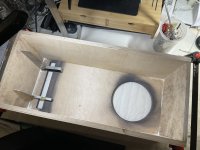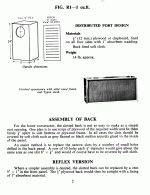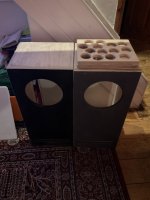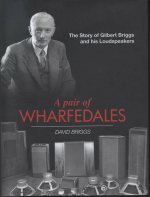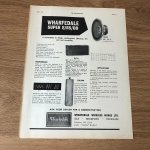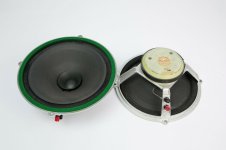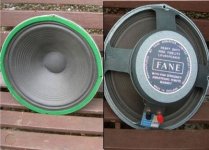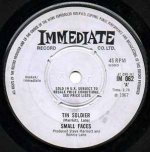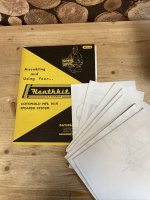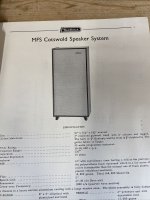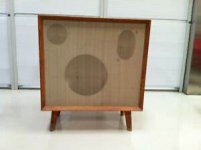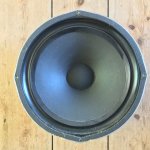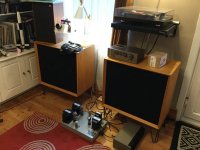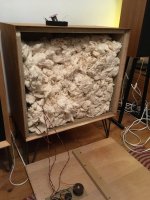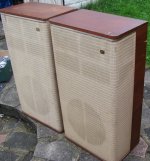I have a pair of 60’s? Pioneer PAX 20g 15ohm Alnico drivers that have been safely packed away for years. I recently tested them and they work fine. It’s winter and Its been a while since I made anything. After a long diversion into solid state I want to build something that will work near field with flea power tubes, a darling I’m thinking of building and a 71A amp I built years ago. Room space is very tight as you can see (bedroom/office) 12x12ft and music is mostly 60’s & 70’s at moderate volumes (neighbours with kids). This will be only my second speaker build, the first being a pair of small back loaded/spiral horns using Tang Band drivers…..very happy with those, currently driven by a quad 303 ….but my 71A amp has 15 ohm outputs. I randomly thought I’d have a go at “classic” Wharfedale 1cu foot cabinets, as they will fit on my stands in the limited space available and it got me using a router to cut holes for the first time. From what I can see the original Pioneer cabinet plans for the PAX-30 a size up from mine are pretty big….I couldn’t find the plans for the 20g. In the cabinet handbook for the 1cu ft Briggs mentions building these either with a “distributed port” (slotted back) or as a straight BR with a tuned 9x1” slot port. This isn’t a vital project, just a bit of fun, but wood isn’t as cheap as it used to be And I can’t decide on…..one or many slots? Anyone got any thoughts between the straight BR or the DP?
Mike
Mike
Attachments
-
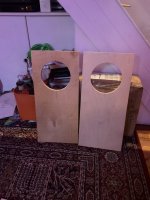 0BD7DADC-B29B-44BD-BB02-192B3E304284.jpeg454.7 KB · Views: 201
0BD7DADC-B29B-44BD-BB02-192B3E304284.jpeg454.7 KB · Views: 201 -
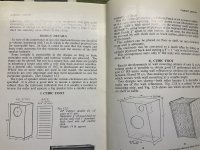 20D0D006-2B82-4563-872E-5FAF588422A9.jpeg651.9 KB · Views: 201
20D0D006-2B82-4563-872E-5FAF588422A9.jpeg651.9 KB · Views: 201 -
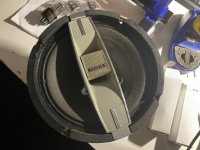 0EDD8F5B-BF41-497F-87E4-785D423C3E3B.jpeg426.1 KB · Views: 213
0EDD8F5B-BF41-497F-87E4-785D423C3E3B.jpeg426.1 KB · Views: 213 -
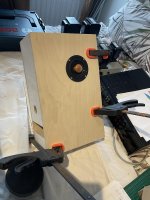 D1E5D3B4-1549-4528-888A-3F4F0B11185B.jpeg79.4 KB · Views: 198
D1E5D3B4-1549-4528-888A-3F4F0B11185B.jpeg79.4 KB · Views: 198 -
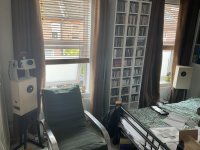 6752BEAE-5E82-4E81-9AA8-665615FD2A7E.jpeg146.9 KB · Views: 191
6752BEAE-5E82-4E81-9AA8-665615FD2A7E.jpeg146.9 KB · Views: 191
The distributed port enclosure gives an open, low resonance sound with good transient response, but lacks the bass reinforcement of a properly designed bass reflex enclosure.
The 9"x1" vent is a flexible compromise to suit drivers of different free air resonance. A tube port tuned to the exact resonant frequency of the particular driver would give a more effective, traditional bass reflex, bass response
The 9"x1" vent is a flexible compromise to suit drivers of different free air resonance. A tube port tuned to the exact resonant frequency of the particular driver would give a more effective, traditional bass reflex, bass response
I see from the PAX-20G specs, Mike, that the drivers can have a resonance frequency anywhere between 50 and 70 Hz.
https://audio-database.com/PIONEER-EXCLUSIVE/unit/pax-20g-e.html
The 9"x1" vent would certainly accommodate such a variation in resonance frequency. However, if you can measure the free air resonance of your particular driver(s), I suggest you go for a port that tunes the enclosure to that resonance frequency in order to produce a traditionally tuned bass reflex enclosure.
In his book Loudspeakers, Gilbert Briggs gives a formula for calculating the length of pipe required for a given enclosure resonance frequency:
f^2 = (2700A) divided by V(L + 0.96√A)
where:
f = enclosure resonance frequency in Hz (f^2 = f squared)
A = area of pipe in square inches
V = volume of enclosure in cubic feet
L = length of pipe in inches
https://audio-database.com/PIONEER-EXCLUSIVE/unit/pax-20g-e.html
The 9"x1" vent would certainly accommodate such a variation in resonance frequency. However, if you can measure the free air resonance of your particular driver(s), I suggest you go for a port that tunes the enclosure to that resonance frequency in order to produce a traditionally tuned bass reflex enclosure.
In his book Loudspeakers, Gilbert Briggs gives a formula for calculating the length of pipe required for a given enclosure resonance frequency:
f^2 = (2700A) divided by V(L + 0.96√A)
where:
f = enclosure resonance frequency in Hz (f^2 = f squared)
A = area of pipe in square inches
V = volume of enclosure in cubic feet
L = length of pipe in inches
Thanks Galu
That’s very useful info, I will do some research but it sounds like a straight reflex is the way to go. I do have a copy of Loudspeakers somewhere which I will have to try and find.
Regards
Mike
That’s very useful info, I will do some research but it sounds like a straight reflex is the way to go. I do have a copy of Loudspeakers somewhere which I will have to try and find.
Regards
Mike
Construction of the “not very scientific” 1cu ft reflex cabs has begun. Had to freehand the top and bottom pieces with a circular saw in my lunch hour with some scrap ply after not paying attention and doing the mm conversions late at night after a long day. Mr sander should deal with any imperfections. Quite pleased with the holes as literally my first go with a router. Anyway these cabs are 15mm birch ply and the Wharfedale cabinet handbook recommended 12mm ….is it worth me adding some additional bracing like a shelf with holes or not? Also Briggs recommended damping all the internal surfaces with 1” “celotex”….I have polyester wadding and carpet spray glue …..still do every internal surface?
Mike
Mike
Attachments
So, Mike, you've gone for the narrow 9" x 1" vent.
Yes, you can line all internal surfaces, apart from the front baffle, with the likes of polyester wadding.
Celotex these days must be a different product (an insulation board) from what it was back in Briggs' day.
Yes, you can line all internal surfaces, apart from the front baffle, with the likes of polyester wadding.
Celotex these days must be a different product (an insulation board) from what it was back in Briggs' day.
Given the height of the enclosure, bracing such as you suggest may be a good idea, although your 15mm ply enclosure looks sturdy.
I wouldn't place the brace dead centre. Asymmetry should be more effective in dealing with panel vibrations.
I wouldn't place the brace dead centre. Asymmetry should be more effective in dealing with panel vibrations.
Hi Galu
Yes I was quite keen to crack on and the couple of YouTube videos I saw on measuring the free air response while saying it was simple didn’t seem that simple to me….don’t be too disappointed 😔 I’m assuming that I can tune the response empirically by stuffing or blanking the port to taste as I go?
Regards
Mike
Yes I was quite keen to crack on and the couple of YouTube videos I saw on measuring the free air response while saying it was simple didn’t seem that simple to me….don’t be too disappointed 😔 I’m assuming that I can tune the response empirically by stuffing or blanking the port to taste as I go?
Regards
Mike
Given the height of the enclosure, bracing such as you suggest may be a good idea, although your 15mm ply enclosure looks sturdy.
I wouldn't place the brace dead centre. Asymmetry should be more effective in dealing with panel vibrations.
Ok I’ll put something in 2/3 down. I know on some of their larger cabsBriggs used a slotted shelf as an acoustic filter but I think that was to avoid low bass from turntable rumble….I’m sure I read that. I’ll probably do a shelf and get the hole cutter to work randomly.
Thx
If the sound is not to your liking, you can certainly experiment by covering the vent internally with soft, felt like cloth or by stuffing it with fibreglass.
That would move the enclosure away from reflex loading towards aperiodic loading - Briggs' distributed port arrangement was a form of aperiodic loading.
'Aperiodic' means 'without period', i.e., 'without resonance'.
I would use an open bracing shelf and not an acoustic filter .
That would move the enclosure away from reflex loading towards aperiodic loading - Briggs' distributed port arrangement was a form of aperiodic loading.
'Aperiodic' means 'without period', i.e., 'without resonance'.
I would use an open bracing shelf and not an acoustic filter .
Ok I’ll put something in 2/3 down.
Just below the speaker cut-out would be a good idea. The extra support to the baffle at that point would be beneficial.
Just below the speaker cut-out would be a good idea. The extra support to the baffle at that point would be beneficial.
Thanks….will do! Hoping to try to get these finished over the weekend.
Mike, if you haven't come across the UK Hi-Fi History Society site then you may be interested in taking a look.
This page contains a selection of Wharfedale enclosure construction plans: http://ukhhsoc.torrens.org/makers/Wharfedale/index.html
Your 1 cu ft enclosure design is in the 'C8 Plans' (see attached).
I've an interest in your project because, back in the day, I built 3 cu ft distributed port enclosures for my Wharfedale 12" full range drivers as well as 2 cu ft narrow vent enclosures for my friend's Wharfedale 10" full range drivers. Both enclosures provided a smooth and uncoloured bass reproduction.
It was all great fun in the days before published Thiele/Small parameters! 😎
This page contains a selection of Wharfedale enclosure construction plans: http://ukhhsoc.torrens.org/makers/Wharfedale/index.html
Your 1 cu ft enclosure design is in the 'C8 Plans' (see attached).
I've an interest in your project because, back in the day, I built 3 cu ft distributed port enclosures for my Wharfedale 12" full range drivers as well as 2 cu ft narrow vent enclosures for my friend's Wharfedale 10" full range drivers. Both enclosures provided a smooth and uncoloured bass reproduction.
It was all great fun in the days before published Thiele/Small parameters! 😎
Attachments
Mike, if you haven't come across the UK Hi-Fi History Society site then you may be interested in taking a look.
This page contains a selection of Wharfedale enclosure construction plans: http://ukhhsoc.torrens.org/makers/Wharfedale/index.html
Your 1 cu ft enclosure design is in the 'C8 Plans' (see attached).
I've an interest in your project because, back in the day, I built 3 cu ft distributed port enclosures for my Wharfedale 12" full range drivers as well as 2 cu ft narrow vent enclosures for my friend's Wharfedale 10" full range drivers. Both enclosures provided a smooth and uncoloured bass reproduction.
It was all great fun in the days before published Thiele/Small parameters! 😎
Hi Galu
I appreciate the interest and thanks for the links. Don’t worry, we are the only ones interested in this thread…..everyone else is busy looking at graphs ;0) Well more progress after work today…..a bit nippy in the garden but I managed to make one of the bracing shelves before the drill battery died and round over the cabinet edges. I was going to paint the fronts black as I had some in (there were a few imperfections in the face of the ply) but now I’m thinking I might go for something a bit more uplifting and vintage like a pale green or duck egg blue and varnish the rest…..I will have a look in B&Q tomorrow. I also need to figure out the best way of mounting the backs ….I’ll probably cut some trim to make an inner lip on the back panel….should have given that a bit more thought.I’ve got sone thick card to make a template for the driver mounting holes and I need to have a rummage for the right hardware. Anyway moving forwards! Apart from the pioneer drivers I also have a set of the not very popular Wharfedale super 8’s with ceramic magnets that I sealed the surrounds on ( they were like a porous mesh) and re-built the rotted foam rings behind the whizzer cones. I have a soft spot for early Wharfedale as years ago I used to have a pair of Mk1 Teesdales with a 15” woofer in infinite baffle and 5 and 3” drivers firing upwards into aluminium half cones. They sounded very good and I regret selling them. I also had a set of refurbished W3’s with Alnico drivers but they’d been re foamed at some point and I could never get them to sound the way I wanted. Your old cabinets sound great.
Regards
Mike
Attachments
Last edited:
Good work on the open bracing shelf (and on the enclosures themselves of course!).
I used 1" by 1" (25 mm by 25 mm) planed softwood strips to form a frame to accept the removable back. Should be available in B&Q. I also used foam draught excluder strip to ensure an airtight seal.
Good to be corresponding with another vintage Wharfedale afficionado!
I bought my Wharfedale RS/12/DD speakers back in 1969 and they have occupied several different enclosures in the ensuing years. They're still going strong today in my Man Cave. I recently acquired a single Super 12/RS/DD in 'as new' condition, simply so I could have, handle and admire it! 🤓
I've never heard the Super 8s, but I reckon they don't deserve the bad press. They need large enclosures (1 cu ft minimum) to give of their best.
I hope you've got a copy of "A Pair of Wharfedales" - highly recommended!
I used 1" by 1" (25 mm by 25 mm) planed softwood strips to form a frame to accept the removable back. Should be available in B&Q. I also used foam draught excluder strip to ensure an airtight seal.
Good to be corresponding with another vintage Wharfedale afficionado!
I bought my Wharfedale RS/12/DD speakers back in 1969 and they have occupied several different enclosures in the ensuing years. They're still going strong today in my Man Cave. I recently acquired a single Super 12/RS/DD in 'as new' condition, simply so I could have, handle and admire it! 🤓
I've never heard the Super 8s, but I reckon they don't deserve the bad press. They need large enclosures (1 cu ft minimum) to give of their best.
I hope you've got a copy of "A Pair of Wharfedales" - highly recommended!
Attachments
Last edited:
I do indeed have a copy of The book ;0) Column 8’s anybody?! Those drivers do look very nice and it’s a testament you’ve had them so long. Very nice cast frames on that era driver. I don’t have any of the larger Wharfedale drivers but do have three 12 inch Grampian reproducers 15 ohm Alnico drivers from 1963 that are of a similar construction. They sound very nice in free air and my next project will hopefully be making some reflex cabs for those (they’ve been in the loft for too long)….I’m a bit limited for space to make massive cabs more’s the pity.Good work on the open bracing shelf (and on the enclosures themselves of course!).
I used 1" by 1" (25 mm by 25 mm) planed softwood strips to form a frame to accept the removable back. Should be available in B&Q. I also used foam draught excluder strip to ensure an airtight seal.
Good to be corresponding with another vintage Wharfedale afficionado!
I bought my Wharfedale RS/12/DD speakers back in 1969 and they have occupied several different enclosures in the ensuing years. They're still going strong today in my Man Cave. I recently acquired a single Super 12/RS/DD in 'as new' condition, simply so I could have, handle and admire it! 🤓
I've never heard the Super 8s, but I reckon they don't deserve the bad press. They need large enclosures (1 cu ft minimum) to give of their best.
I hope you've got a copy of "A Pair of Wharfedales" - highly recommended!
Regards
Mike
No massive cabs allowed in my marital home - more's the pity! 😉
My first ever enclosure, built when a teenager, was 5 cu ft in volume with a huge, rectangular reflex tunnel. Power was supplied by a mono valve amp.
It was tuned to a Fane 122/10's free air resonance of 40 Hz. The moment I heard the depth of bass it extracted from my 45 rpm mono single of Tin Soldier by the Small Faces I was hooked!
My first ever enclosure, built when a teenager, was 5 cu ft in volume with a huge, rectangular reflex tunnel. Power was supplied by a mono valve amp.
It was tuned to a Fane 122/10's free air resonance of 40 Hz. The moment I heard the depth of bass it extracted from my 45 rpm mono single of Tin Soldier by the Small Faces I was hooked!
Attachments
I was -1 yrs old when that single came out! My front room is home to a pair of Heathkit Cotswolds with 12” Fane woofers…..infinite baffle but very nice sounding speakers….they were picked up to replace the Teesdales.No massive cabs allowed in my marital home - more's the pity! 😉
My first ever enclosure, built when a teenager, was 5 cu ft in volume with a huge, rectangular reflex tunnel. Power was supplied by a mono valve amp.
It was tuned to a Fane 122/10's free air resonance of 40 Hz. The moment I heard the depth of bass it extracted from my 45 rpm mono single of Tin Soldier by the Small Faces I was hooked!
I can't resist researching this - blame nostalgia! 🤓
Heathkit certainly advertised the Fane 122/12 bass driver (i.e. 12" and 12,000 gauss magnet) for sale as a 'naked' driver in the early days.
The 122/12 has a synthetic roll surround, whereas my 122/10 (10,000 gauss) has a pleated paper surround.
Are your front room speakers the MFS Cotswold, or perhaps the older square shaped Cotswold?
Heathkit certainly advertised the Fane 122/12 bass driver (i.e. 12" and 12,000 gauss magnet) for sale as a 'naked' driver in the early days.
The 122/12 has a synthetic roll surround, whereas my 122/10 (10,000 gauss) has a pleated paper surround.
Are your front room speakers the MFS Cotswold, or perhaps the older square shaped Cotswold?
Attachments
The original square ones ….I picked them up locally a few years ago for just £25 from an old gent who lived locally and was a bass player back in the day. He had them in a home studio and had lost the legs and the cloth needed re doing. I Gave them a re cap. Due to lack of space if you aren’t sat right in front that are like a giant mono speaker 😀 For info attached are their predecessor the Teesdale mk1. PS the manual you linked references celotex so I’m thinking it’s the crepe paper like stuffing in my Cotswolds.I can't resist researching this - blame nostalgia! 🤓
Heathkit certainly advertised the Fane 122/12 bass driver (i.e. 12" and 12,000 gauss magnet) for sale as a 'naked' driver in the early days.
The 122/12 has a synthetic roll surround, whereas my 122/10 (10,000 gauss) has a pleated paper surround.
Are your front room speakers the MFS Cotswold, or perhaps the older square shaped Cotswold?
Attachments
Last edited:
- Home
- Loudspeakers
- Full Range
- A blast from the past …Wharfedale 1cu ft cabinets
